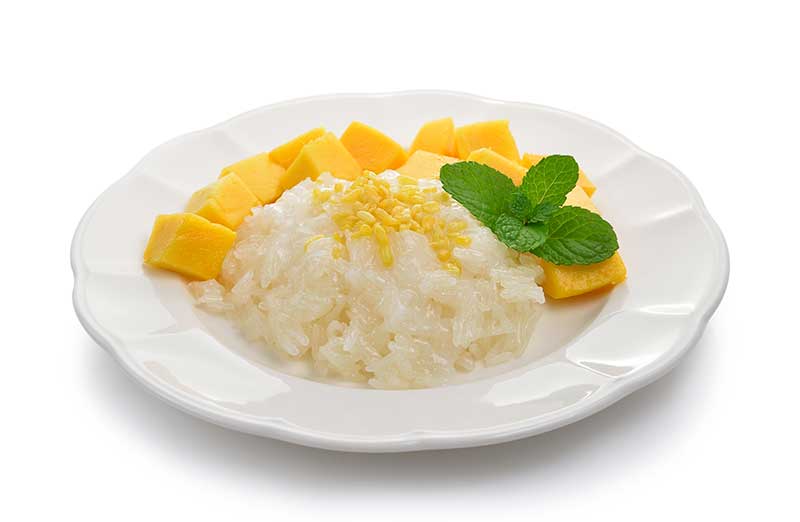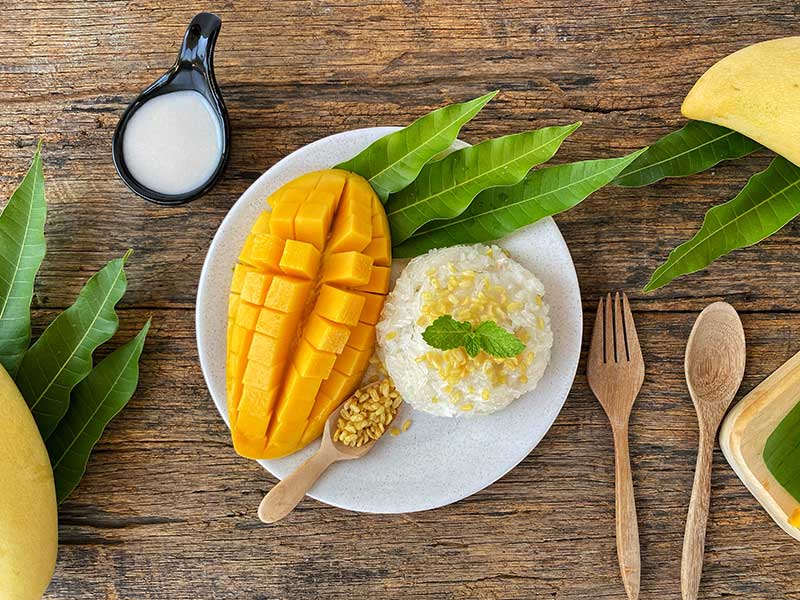Mango Sticky Rice is one of the most popular Thai desserts and exemplifies the cuisine’s reputation for bold flavors and unusual ingredients. This dessert is loved by both locals and visitors for its refined simplicity and the harmonious blend of sweet and savory flavors it provides.
Khao Niew Ma Muang, or Mango Sticky Rice, is a popular Thai dessert made by simmering glutinous rice in sweetened coconut milk and topping it with slices of fresh, ripe mango. The dish can be found on the menus of many restaurants around the world and is a staple of Thai street food.
Glutinous rice is traditionally soaked in water for several hours to soften the grains before being used in the dish. Next, coconut milk is used to cook the rice, making it extra creamy and luscious. Sugar is added to the coconut milk for flavor, and a little salt is added to cut the sweetness.
After the rice has finished cooking, it is served on a plate or in a bowl, and then slices of fresh mango are placed atop the rice. Mangoes should be sweet and tangy and firm at the same time so that they can stand up to the richness of the rice.
Toasted sesame seeds or shredded coconut are common toppings because of their crunch and textural contrast to the rest of the dish. In some iterations, sweetened condensed milk or coconut cream is drizzled on top.
The Mango Sticky Rice is not only tasty but also healthy. Coconut milk contains healthy fats that can help improve cholesterol levels and support heart health, and glutinous rice is a good source of carbohydrates that can keep you going all day. In addition to their delicious flavor, mangoes are a great way to get your daily dose of vitamins and antioxidants.
Finally, Mango Sticky Rice is a sweet treat that exemplifies the distinct tastes and culture of Thailand while still being delicious and healthy. Whether you try it as a cheap snack on the street or an expensive dessert at a restaurant, it will satisfy your sweet tooth.
Here is a recipe to make it at home:
Ingredients:
- 1 cup of glutinous rice
- 1 can of coconut milk
- 1/2 cup of granulated sugar
- 1/4 teaspoon of salt
- 2 ripe mangoes
- Sesame seeds (optional)
- Mint leaves (optional)

Instructions:
- Rinse the glutinous rice until the water runs clear. Soak it in water for at least 30 minutes, or up to 4 hours.
- Drain the rice and place it in a steamer basket lined with cheesecloth. Steam the rice for 20-25 minutes, or until it’s cooked through.
- While the rice is cooking, prepare the sauce by combining the coconut milk, sugar, and salt in a saucepan. Heat the mixture over medium heat, stirring occasionally, until the sugar has dissolved. Remove from heat and let it cool.
- Once the rice is cooked, transfer it to a bowl and pour half of the coconut sauce over the rice. Mix well and let it sit for 10 minutes.
- Cut the mangoes into thin slices or cubes.
- To serve, scoop the rice into bowls or plates and top with the mango slices. Drizzle the remaining sauce over the mango and rice. Sprinkle with sesame seeds and garnish with mint leaves if desired.
Enjoy your delicious homemade Thai Mango Sticky Rice!
Tips to make the best Thai Mango Sticky Rice:
- Use high-quality glutinous rice: The quality of the rice is crucial to making the perfect sticky rice. Look for Thai glutinous rice, also known as sweet rice or sticky rice, at Asian grocery stores. Avoid using regular rice as it won’t have the same texture.
- Soak the rice: Soaking the rice for at least 30 minutes before cooking helps to soften the grains and remove excess starch, resulting in a better texture and taste.
- Steam the rice: Steaming is the traditional method for cooking sticky rice, and it ensures that the rice is cooked evenly and doesn’t become mushy. If you don’t have a steamer, you can use a rice cooker or a pot with a tight-fitting lid.
- Use fresh coconut milk: Using fresh coconut milk, either homemade or canned, will give your sauce a richer and more authentic flavor. If you’re using canned coconut milk, make sure to shake it well before opening the can.
- Don’t overcook the sauce: Heat the coconut milk sauce over medium heat and stir occasionally until the sugar has dissolved. Don’t let it boil or simmer for too long, or the sauce will become too thick and cloying.
- Choose ripe and sweet mangoes: The mangoes should be ripe but not overripe, with a sweet and juicy flesh. Look for mangoes that are fragrant and have a slight give when gently pressed.
- Serve at room temperature: Mango Sticky Rice is best served at room temperature, allowing the flavors to meld together and the sauce to be absorbed by the rice.
By following these tips, you’ll be able to make a delicious and authentic Thai Mango Sticky Rice that will impress your family and friends.

